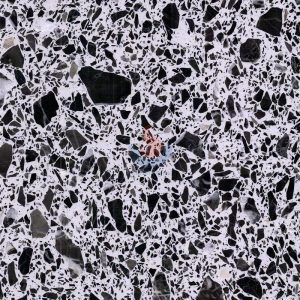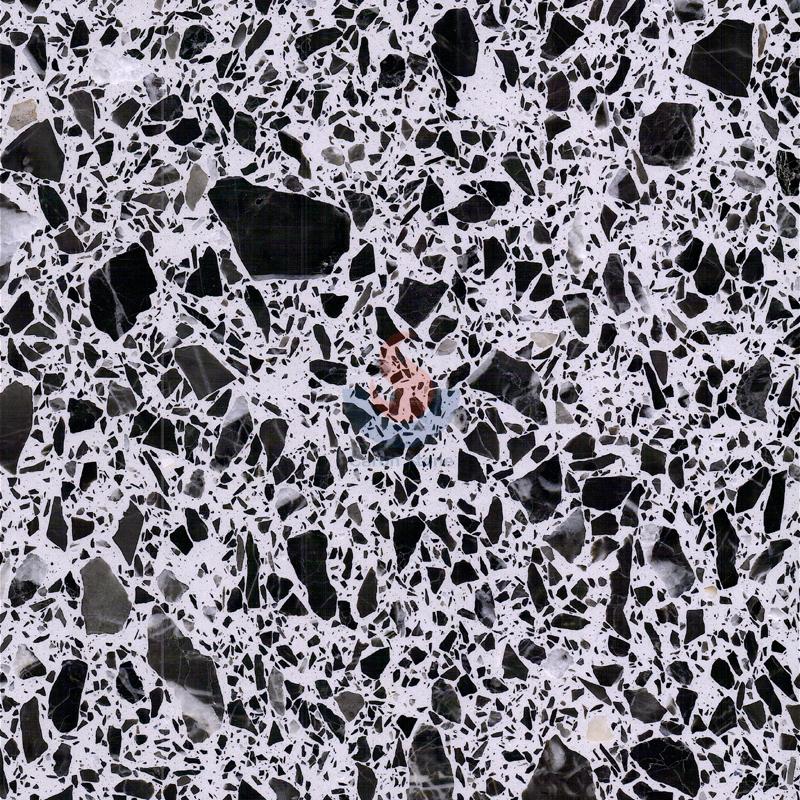In exploring the origin and evolution of terrazzo, we can’t help but be attracted by the story behind this material. Terrazzo, once regarded as an outdated decoration, is now reborn in the design world with its unique aesthetics and practicality. Its birth did not come from a carefully designed laboratory, but from a simple and smart waste utilization. The history of this material, from the hands of craftsmen in Venice in the 16th century to the creative studios of modern designers, tells a story about innovation, aesthetics and sustainability. This article will take you through time and space to understand in depth how terrazzo has gradually become an indispensable artistic element in modern design from neglected scraps.

Terrazzo CRW303
Its birth
From waste utilization
Ask our parents, they should be impressed by terrazzo. In the 1980s, it was the standard for corridors in Chinese schools and hospitals.
Although it looks a bit monotonous and rustic now, it was considered a high-end decorative art at the time.
But who would have thought that its birth came from “stealing” and “waste utilization”?
The time goes back to Venice in the mid-16th century, when local nobles invited craftsmen to decorate their homes, using high-grade marble.
Ordinary people naturally couldn’t afford expensive marble, so the leftover scraps were also treated as treasures.
The workers would go home after get off work, build the exterior walls of their homes, and polish them with goat milk to enhance the gloss. This is the prototype of “terrazzo”.
Yes, terrazzo existed as a substitute for marble at the beginning.
In the 18th century, cement was invented in Britain. From then on, a handful of cement was matched with a handful of marble fragments, and the most classic formula of “terrazzo” came out.
In addition to marble, you can also add quartz, granite, glass and other ingredients, and even broken green sticks can be put in, just like a cup of milk tea filled with various carbon waters, very satisfying!
With more than 200 years of development, the terrazzo method in the early 20th century was already quite sophisticated, but at that time people used it just for its durability, not for its appearance.
It was not until the 1920s that designers noticed this potential stock. The psychedelic and changeable appearance that can be put on the wall and on the ground, and the plasticity that can be straight or bent, made them unable to control themselves, and also produced many classic cases.
For example, the square monument of the Hoover Dam has a large terrazzo floor with a star map embedded in the base, depicting the sky in the northern hemisphere when the dam was completed.
Another example is the Hollywood Walk of Fame, a street inlaid with more than 2,500 five-pointed terrazzo and brass stars, in order to commemorate the top stars in the entertainment industry.
Later in the 1980s, Japanese industrial designer Shiro Kuramata had a great idea and used colored glass fragments instead of stone as terrazzo, named it “Star Piece”, and used this material to design stores around the world for his good friend “Issey Miyake”.
In 1983, Shiro Kuramata also designed tables and chairs named “Kyoto” and “Nara” for the Memphis Group. Yes, it is the “Memphis” you often see when searching for PPT templates. “Star Piece” also coincides with Memphis’ design concept of “bright, geometric, repetitive, and highly saturated”, becoming a classic Memphis-style work in the 1980s.
In 1988, Ettore Sottsass, the founder of Memphis, founded a magazine and named it Terrazzo after terrazzo, which shows his love for this material.

Terrazzo CRW221
The story of terrazzo is not only a model of material innovation, but also a leap in design thinking. From Venetian craftsmen to modern designers, the evolution of terrazzo has witnessed mankind’s unremitting pursuit of beauty and practicality. Its revival is not only nostalgic, but also an infinite imagination of future design possibilities.





